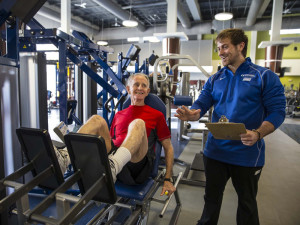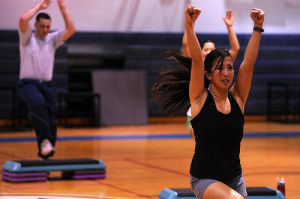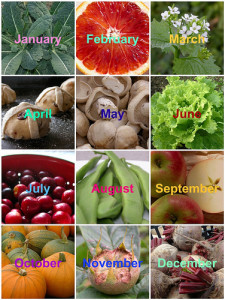by Michelle Sutton-Kerchner
We cannot get enough of the mild, fresh days of spring. Help assure a full lifetime of them by practicing healthy living …

Fate may have our days predetermined. What transpires during them is up to us. We even may be able to squeeze extra years out of our destiny. You don’t need to revamp your life. We all have those vices we simply refuse to quit. (Cookies, anyone?) Simple adjustments to your routine may be all it takes to experience spring, and all life’s seasons, well into old age.
Exercise
Health experts in every field emphasize the importance of exercise in aging well. It is possible to add 3.4 years to your life through 150 minutes of weekly moderate-intensity exercise, according to one study. The time is well worth the investment, considering the endless list of immediate and shorter term benefits you also gain.
For all who work out with weight loss as the driving force, it’s time to reconsider your motives. A healthy weight is one great result of living a fit life. However, a few extra pounds may not impact your life extent.
A study recently published in the Journal of the American Medical Association (JAMA) showed a decrease in mortality rates for individuals with a BMI between 25 and 30, compared to those of a lower weight. It was not until BMI numbers reached into the 30s that they impacted mortality. Be careful though. A BMI of 35+ showed an increase in mortality of 29 percent compared to those of lower numbers.
Researchers theorize a minimal amount of extra fat may be helpful in battling acute or chronic illnesses. Literally, sweat less over those few extra pounds, and more to keep yourself healthy. (What’s more inspiring– a swimsuit or some extra time on earth? Exactly.)
This study does not discount the mental and physical benefits of a lower BMI. Rather, it emphasizes the bigger picture. Health is impacted by myriad factors, so don’t obsess over a few stubborn pounds. Regular exercise pays off, even if not reflected in your jeans size.

Strength training provides long- and short-term health benefits. It helps preserve bone density and muscle mass, and improves heart health. These are key factors in healthy aging because they help avoid conditions common in older populations, including osteoporosis, arthritis, and heart disease. An appropriate resistance training routine helps maintain mobility, balance, and functionality. Living a long life is even better when it can remain a productive one.
A study published in the American Journal of Medicine found building muscle mass to be associated with decreased metabolic risk factors. Body composition is gaining popularity as a predictor of mortality.
Dr. Arun Karlamangla, the study’s co-author and an associate professor in the geriatrics division at the Geffen School at UCLA, indicates the greater one’s muscle mass, the lower one’s risk of death. The exact cause-and-effect is unclear. However, he emphasizes maximizing and maintaining muscle mass. It can only help, at any age. Seniors, aquatic workouts provide an ideal environment for gentle but effective resistance training.
Be sure to schedule time for aerobic fitness. Keep the heart muscle strong for longevity. Try alternating strength training with cardio work to accomplish a balanced fitness routine. Expel stress, along with calories, to stay balanced and strong despite life’s challenges.
Complement your formal fitness routine by incorporating more movement into the day. Some think a Center visit fulfills their daily requirement of physical activity. Spending the day’s other waking hours sedentary has a negative impact. It could even counteract your fitness efforts.
Be conscious of how much time you spend sitting. Are you a distance commuter, office worker, bookworm, TV addict? A combination of several? You may tackle a powerful workout, but you still need to engage in physical activity beyond the Exercise Floor. Frequently incorporate movement during your day. Some ideas:
- stand or pace while on the phone
- walk to a coworker instead of e-mailing him/her
- do jumping jacks or short reps of other exercises in between tasks
- go for short walks (a must for dog owners and we know they’re healthier for it)
- run the stairs for a quick cardio boost

A personal trainer or Group Fitness instructor can share additional ideas on adding movement to otherwise non-active times. Have a set of dumbbells by your chair for a quick lift session. A trainer can help you complement your fitness routine with exercises to execute while working or watching TV.
Make friends with a kettlebell. This compact, portable tool works the entire body. Give yourself some space and start swinging (properly, of course). Your workday may feel less stressful and your free time, more productive.
While sitting, the body is in an idling state and muscles go silent. Circulation decreases, and risk of blood clots may increase. During prolonged idle periods, artery-damaging fats are more likely to build up in the bloodstream. Get your system moving!
Along with improving your health, frequent movement burns more calories and helps prepare for your formal workout. Take a breather and move.
Eat Better

Researchers who interviewed centenarians tried to determine dietary secrets that may have nourished them to live 100 or more years. Their eating followed a specific pattern, though not of any modern trend. Their diet focused on plant-based foods, prepared to taste appetizing.
Perhaps that is where we fail in today’s nutrition. The list of our healthiest superfoods changes frequently as we discover more behind the science of food. Knowing the best food choices and deciding to eat them are two different things. It can be assumed centenarians, who reap the value of plant-based meals, also know how to prepare them to their liking. They spent a lifetime eating foods with minimal processing and additives. They have enjoyed recipes passed down through generations. Ingredients were simple and natural.
Try to attend a nutrition seminar or cooking classes that include recipes and samples. Knowing which foods to eat is helpful, but knowing how to cook them gets them eaten. Think: Big pot filled with fresh veggies, beans, and other wholesome ingredients– flavored to your preference. Food for longevity.
Along with what you eat, portion control and prep can affect aging. Overcooked food is thought to accelerate aging. Crisp or charcoaled coating is the culprit. Easy swaps include lightly toasting bread, poaching eggs instead of frying them, and baking in place of grilling.
Avoid overeating, which stresses the digestive system while piling on unneeded calories. Stop eating before you feel full. Give the brain time to register your satisfied hunger before going for second helpings. This may take up to 20 minutes.
Live Like You Mean It
Studies of the elderly population prove purposeful living has a biochemical impact. Communities with strong social support networks and close family, biological or “adopted,” tend to be nurtured for a longer life. It is easier to thrive at any age when loved ones depend on you. It is also easier to face life’s challenges when you can depend upon loved ones.
We all realize the health perks of the “family meal.” A regularly shared, sit-down meal is touted as helping everything from maintaining a healthier weight to better grades and more confidence for children. Take that concept to the next level. Share a meal, experiences, simply spend time in each other’s presence and create true well-being.
These are the moments we cherish. Live to create more of them, and you will grow old among friends. Youth doesn’t have to be wasted on the young, and the elderly don’t have to keep wisdom to themselves. Bridge the generations for a culture grown out of individual strengths, which complement each other.

A long life is often based on a spiritual or religious foundation. Sacred rituals, anything from meditation to organized religion, perpetuate life. They do not need to be religious based. Some cultures have a daily nap, which is considered a sacred ritual. Others make tea time an art form.
Stargaze, bird watch, practice yoga or T’ai Chi, execute an exercise. All of these are ritualistic forms, which can be made sacred by respecting and honoring a commitment to them. These activities encourage us to think outside our present world and consider the mysteries of life. Perhaps in recognizing we are a star among the universe, we are inspired to learn more and live fuller. We subconsciously become determined to discover more tomorrows.
Sleep
 After tweaking our lifestyle to include more of the aforementioned longevity tips, you will be ready for a good slumber. A solid night’s rest has countless health benefits, both mental and physical. Sleep replenishes the body and all its systems. It heals everyday wear on muscles and tissues, reduces stress and depression, and helps maintain a healthy weight.
After tweaking our lifestyle to include more of the aforementioned longevity tips, you will be ready for a good slumber. A solid night’s rest has countless health benefits, both mental and physical. Sleep replenishes the body and all its systems. It heals everyday wear on muscles and tissues, reduces stress and depression, and helps maintain a healthy weight.
Recent research indicates good sleeping habits may help prevent Alzheimer’s disease. According to research published in JAMA Neurology, the emergence of Alzheimer’s plaques can disrupt sleep, and the resulting lack of sleep contributes to the formation of more plaque. As you strive to live longer, make the most of those days with the preventative measure sleep provides.
Above All …
Live a life that allows you to put your head on the pillow at night and enjoy a peaceful rest.
Sources
“Fit Facts: Lift Weights or Die,” by Paige Waehner at www.about.com.
“Older Adults: Build Muscle and You’ll Live Longer,” at www.newswise.com.
www.everydayhealth.com.
 Fitness & Wellness News Your Source for Fitness News, Wellness News, Health News, and Nutrition News!
Fitness & Wellness News Your Source for Fitness News, Wellness News, Health News, and Nutrition News!




